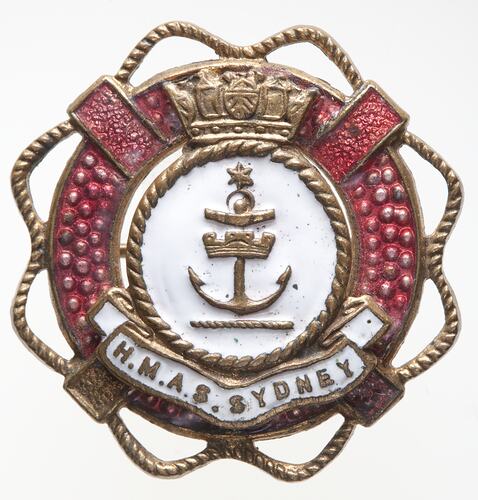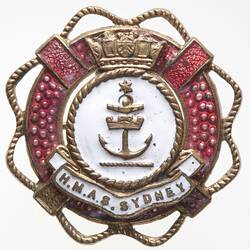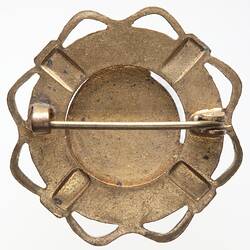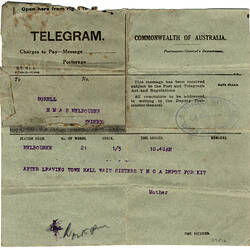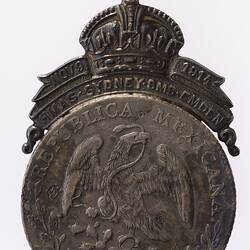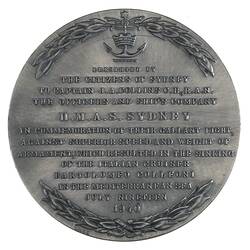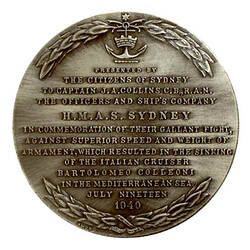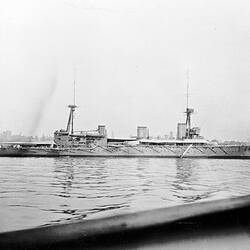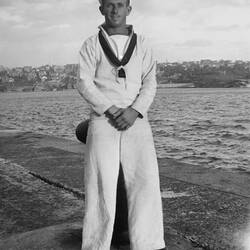Summary
HMAS Sydney enamelled sweetheart badge. Sweetheart badges such as this example were produced during World War I for those serving on Australian warships to send to loved ones and relatives left at home.
The HMAS Sydney was a 5,400 ton light cruiser built for the Royal Australia Navy by the London & Glasgow Engineering Co, Scotland. Launched in 1912 and commissioned at Portsmouth on 26 June 1913, the Sydney become part of the RAN's first modern purpose-built fleet. After initial service in Australian waters, following the outbreak of the First World War in August 1914, Sydney escorted the RAN submarines AE1 & AE2 to Singapore and was engaged in operations against Germany's Pacific colonies, destroying a radio station in the Pelew Islands. Returning to Australian waters, Sydney joined the escort of the first troop convoy from Australia to the Middle East, which left Albany on 1 November 1914. Eight days later, the Sydney became involved in its most famous action when it was detailed to leave the convoy and investigate reports of an unknown vessel off the Cocos (Keeling) Islands. It discovered the German light cruiser SMS Emden that was attacking the British Cable & Wireless Station on the island, aimed at destroying a key part of the communications network that linked Australia to the outside world through submarine telegraph cables that passed via the Cocos (Keeling) Islands to Batavia (Indonesia) and Mauritius. In the ensuing battle the Sydney was able to use its faster speed and greater gun range to completely disable the Emden which eventually ran aground and surrendered. During the later part of the War, the Sydney carried out patrol duties in the Altantic, then joined the Royal Navy's Grand Fleet in the North Sea. In 1917, Sydney was fitted with an aircraft launching platform and equipped with a Sopwith Pup fighter.
On 1 June 1918, while patrolling in the Helgoland Bight, Sydney launched her aircraft to engage two German reconnaissance aircraft managing to shoot down one of the enemy planes. The Sydney was present at the surrender of the German High Seas Fleet on 21 November 1918. She returned to Australia on 19 July 1919 and after the war carried out routine fleet duties until paid off in 1928.
Physical Description
Brass badge in the shape of a lifebuoy, with a crest of the HMAS Sydney in the centre. The buoy is red enamel, and the crest is white enamel, with a brass anchor in the centre and a brass crown above. A scroll beneath the crest is white enamel, with the name of the ship in brass. Brass resembling rope surrounds the badge with an eight-pointed design. There is a pin on the reverse.
Obverse Description
Brass, in the shape of a lifebuoy with red and white enamel.
Significance
The Royal Australian Navy was formed in 1911. The Chatham class light cruiser HMAS Sydney was one of the first fleet units arriving in Sydney in 1913 and in November 1914 destroyed the commerce raiding German cruiser SMS Emden which was beached on one of the Cocos Islands. This badge is associated with HMAS Sydney (I) which is one of the most notable warships in the history of the RAN largely as a result of this action. The destruction of the Emden was a great source of national pride in Australia even before the Gallipoli landings. This badge reflects national pride and is typical of the souvenirs sent home by servicemen to wives and girlfriends at home.
More Information
-
Collecting Areas
Numismatics & Philately, Transport, Public Life & Institutions
-
Acquisition Information
Purchase
-
Ship Depicted
HMAS Sydney (Warship), Royal Australian Navy (RAN), 1914-1918
-
Material
Enamel
-
Classification
-
Category
-
Discipline
-
Type of item
-
Overall Dimensions
30 mm (Width), 6 mm (Depth), 30 mm (Height)
-
Shape
Round
-
Keywords
